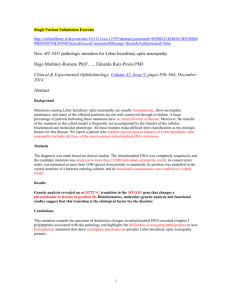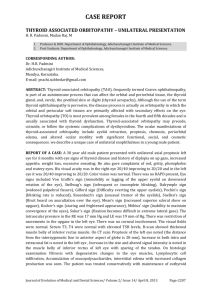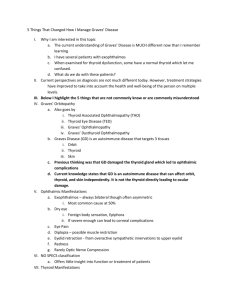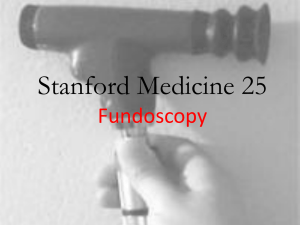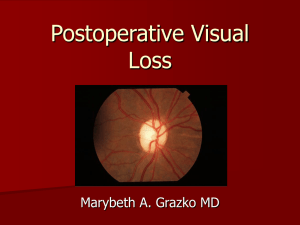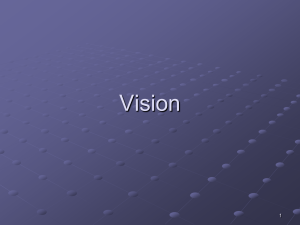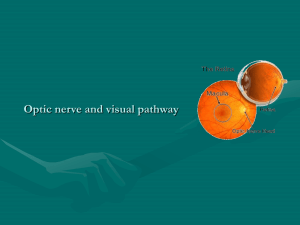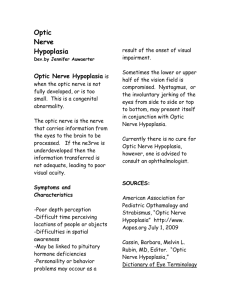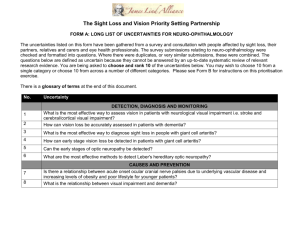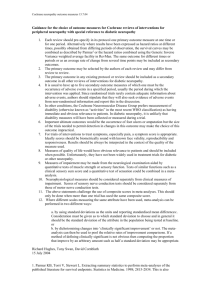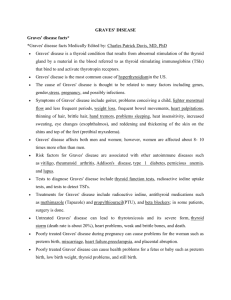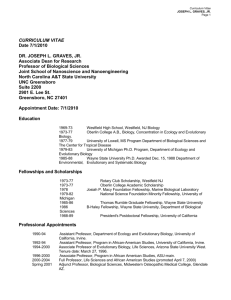Introduction doc
advertisement
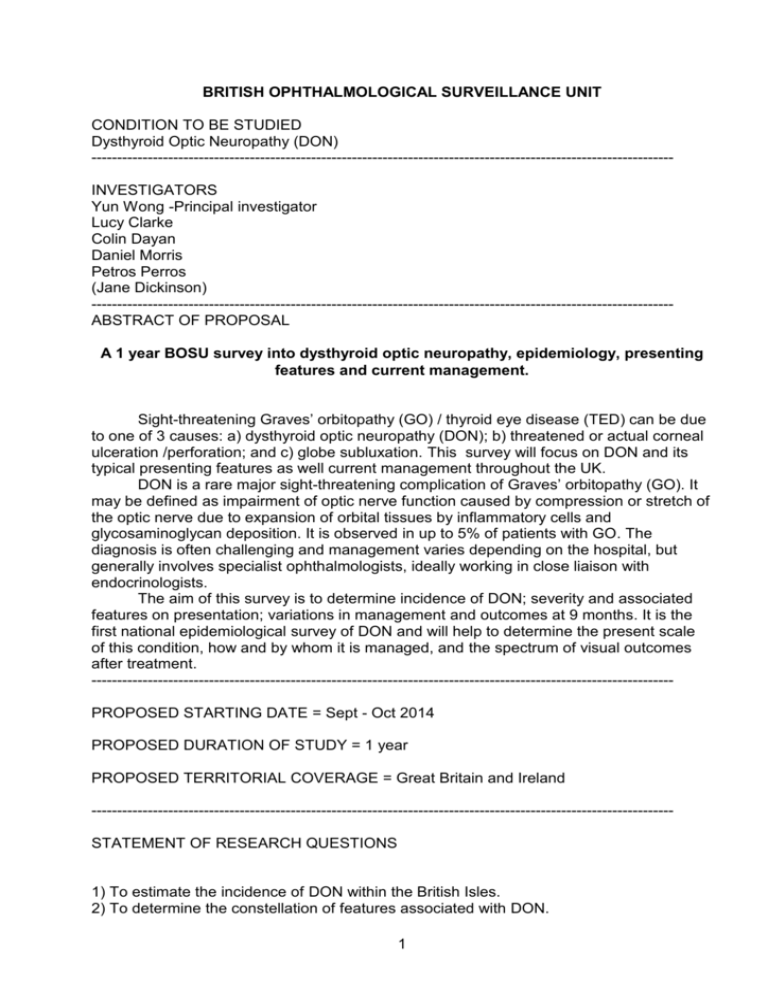
BRITISH OPHTHALMOLOGICAL SURVEILLANCE UNIT CONDITION TO BE STUDIED Dysthyroid Optic Neuropathy (DON) -----------------------------------------------------------------------------------------------------------------INVESTIGATORS Yun Wong -Principal investigator Lucy Clarke Colin Dayan Daniel Morris Petros Perros (Jane Dickinson) -----------------------------------------------------------------------------------------------------------------ABSTRACT OF PROPOSAL A 1 year BOSU survey into dysthyroid optic neuropathy, epidemiology, presenting features and current management. Sight-threatening Graves’ orbitopathy (GO) / thyroid eye disease (TED) can be due to one of 3 causes: a) dysthyroid optic neuropathy (DON); b) threatened or actual corneal ulceration /perforation; and c) globe subluxation. This survey will focus on DON and its typical presenting features as well current management throughout the UK. DON is a rare major sight-threatening complication of Graves’ orbitopathy (GO). It may be defined as impairment of optic nerve function caused by compression or stretch of the optic nerve due to expansion of orbital tissues by inflammatory cells and glycosaminoglycan deposition. It is observed in up to 5% of patients with GO. The diagnosis is often challenging and management varies depending on the hospital, but generally involves specialist ophthalmologists, ideally working in close liaison with endocrinologists. The aim of this survey is to determine incidence of DON; severity and associated features on presentation; variations in management and outcomes at 9 months. It is the first national epidemiological survey of DON and will help to determine the present scale of this condition, how and by whom it is managed, and the spectrum of visual outcomes after treatment. -----------------------------------------------------------------------------------------------------------------PROPOSED STARTING DATE = Sept - Oct 2014 PROPOSED DURATION OF STUDY = 1 year PROPOSED TERRITORIAL COVERAGE = Great Britain and Ireland -----------------------------------------------------------------------------------------------------------------STATEMENT OF RESEARCH QUESTIONS 1) To estimate the incidence of DON within the British Isles. 2) To determine the constellation of features associated with DON. 1 3) To determine variations in management strategies in DON. 4) To determine visual outcomes in treated DON. -----------------------------------------------------------------------------------------------------------------GENERAL SUPPORTING STATEMENT It has been estimated that DON may affect up to 5% of all patients with GO. For patients with significant GO presenting to ophthalmologists the estimate is 10% (1), with a higher prevalence in older male patients and those with concomitant vascular disease, however recent evidence is emerging (unpublished EUGOGO data) that the incidence of all forms of sight-threatening GO may be declining. There are two important reasons to try to estimate the incidence of DON in the current UK population: firstly, a major international initiative (the Amsterdam Declaration) is currently underway to improve outcomes for patients with all forms of GO, and secondly, services for patients with sightthreatening GO are currently being developed as part of specialist commissioning. This BOSU survey gives a unique opportunity to estimate the incidence of DON in Great Britain and Ireland with reasonable confidence. Accurate diagnosis of DON remains controversial as its definition has never been universally agreed. A EUGOGO survey across Europe in 2007 (2) indicated that the most useful clinical features are disc swelling, impaired colour vision and evidence of apical crowding on imaging. Unfortunately no sign is consistently present (e.g. only 50% show optic disc swelling) and the diagnosis currently rests on a constellation of features. It is therefore of interest to determine the signs that prompt a diagnosis of DON and any significant variations in this between clinicians. Additionally, data from outcomes of intervention may give insight into which presenting features are of greatest clinical relevance. These may include the importance of isolated defects on perimetry, and the possible impact of ethnically determined orbital configuration. There is currently no Gold Standard management protocol for DON and medical or surgical treatment may be chosen. It would be of great interest to ascertain which initial treatment is chosen and whether this depends on any local factors e.g. available surgical expertise. A small previous study (3) suggests that there is a greater need for subsequent medical treatment if surgery is chosen as the initial intervention than vice versa, and this survey could help to confirm or refute that. In both instances this survey would give valuable information on the final visual outcomes after treatment, about which there is currently little known. The results of this important survey would improve our understanding of DON and potentially guide optimal future management, thus improving patient outcomes. 1)L Bartalena, A Pinchera, C Marcocci. Management of Graves' ophthalmopathy: reality and perspectives. Endocrine Reviews 2000 21 168-199. 2) Clinical features of dysthyroid optic neuropathy: a European Group on Graves' Orbitopathy (EUGOGO) survey. Br J Ophthalmol. 2007 Apr;91(4):455-8. 3) Wakelkamp IM, Baldeschi L, Saeed P, et al. Surgical or medical decompression as a first-line treatment of optic neuropathy in Graves' ophthalmopathy? A randomized controlled trial. Clin Endocrinol (Oxf). 2005;63(3):323-328. -----------------------------------------------------------------------------------------------------------------2 STUDY METHODS This is a prospective observational survey of DON over a 1 year period. Incident cases will be identified via a questionnaire designed and reviewed by thyroid eye disease experts. A second questionnaire at 9 months will review patient outcomes and should hopefully highlight important management steps necessary for a good prognosis. -----------------------------------------------------------------------------------------------------------------CASE DEFINITION AND INCLUSION CRITERIA a) Graves orbitopathy: For the purposes of this survey patients must have Graves’ orbitopathy which is defined as an orbitopathy in the context of autoimmune thyroid disease. If any doubt exists there should be evidence of thyroid dysfunction or thyroid autoimmunity. b) Dysthyroid optic neuropathy (DON): 1) To meet the criteria for inclusion in this study, we have chosen to limit our definition of DON to patients with 3 or more of the following features in at least one eye. Disc swelling Impaired visual acuity (less than 6/6 or LOGMAR equivalent). Impaired colour vision: at least 2 errors on testing with Ishihara or 1 error on HRR plates (HRR plate numbers 5-9) RAPD Reproducible defect on automated perimetry in eyes with acuity of > 6/18 OR abnormal visual evoked potential (VEP) Of course, none of these features should be used to define DON if due to alternative pathology. 2) If DON is diagnosed then for the patient to be included, it should be thought to be reversible with treatment. For the purposes of this study, patients with DON of > 6 months duration should not be included. 3) A case of DON which has been reported to BOSU but which relapses during the followup period in the eye being treated should not be reported as a new case. 4) A case of DON newly affecting the second eye where the first eye was already reported to BOSU and the patient is in the follow up period for the first eye should be reported anew for the second eye. REPORTING INSTRUCTIONS All questionnaires should be returned in an envelope provided to Dr Yun Wong. ETHICAL APPROVAL Awaiting confirmation at the Royal Victoria Infirmary Support from TEAMeD(UK) and BOPSS 3

